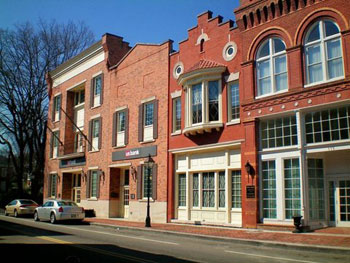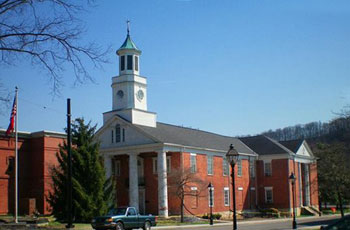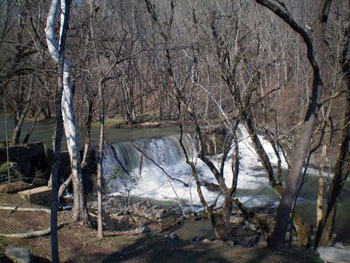
Rogersville, Tennessee
by Melanie Harless
The intriguing past of Rogersville, Tennessee begins in the late eighteenth century. A good place to begin enjoying this history is Crockett Springs Park located in the central part of town off W. Main Street, accessible from Rogers Street or Rogan Road. Here one will find Rogers Cemetery where Davy Crockett’s grandparents are buried. Also buried there are Joseph Rogers, the town’s founder, and his wife, Mary. In 1775 the grandparents of Davy Crockett settled in Crockett Spring. In 1777, when the settlers were attacked by Native Americans, all but decimating the family, the Crocketts sold the property to Colonel Thomas Amis. Joseph Rogers, who was born in Ireland in 1764, arrived in the area in 1785. He stayed at a tavern adjacent to Colonel Amis’ home. He fell in love with the Colonel’s 16-year-old daughter, Mary, and they married in 1786, against Amis’ wishes. Amis later ceded the land he’d purchased from the Crocketts to Joseph Rogers and that land was the site of what was to become Rogersville.
 The land that forms the town was originally part of Spencer County, North Carolina, and then it became part of the state of Franklin, then went back to North Carolina, and finally became part of Hawkins County, Tennessee. During the time Hawkins County was being shifted from one state to the other, it was for a while part of the Territory South of the River Ohio, and in 1791 the first newspaper in the Territory was printed. It was called the Knoxville Gazette and in 1792 was moved to Knoxville, the new capital of the Territory. Rogersville’s Tennessee Newspaper and Printing Museum reflects the area’s long involvement with the printing industry. It is located in the Southern Railway Train Depot. The Depot was built in 1890 and also houses the offices of the Rogersville Heritage Association. A centerpiece of the museum is the last linotype machine to be used to set type for a newspaper in Tennessee. It came from the Rogersville Review where it was used until l982. Many newspapers from Rogersville’s history, some original copies, some photocopies, are also on exhibit. The museum, at the corner of Depot and Broadway, is free but it is currently open limited hours and by appointment (423-272-1961).
The land that forms the town was originally part of Spencer County, North Carolina, and then it became part of the state of Franklin, then went back to North Carolina, and finally became part of Hawkins County, Tennessee. During the time Hawkins County was being shifted from one state to the other, it was for a while part of the Territory South of the River Ohio, and in 1791 the first newspaper in the Territory was printed. It was called the Knoxville Gazette and in 1792 was moved to Knoxville, the new capital of the Territory. Rogersville’s Tennessee Newspaper and Printing Museum reflects the area’s long involvement with the printing industry. It is located in the Southern Railway Train Depot. The Depot was built in 1890 and also houses the offices of the Rogersville Heritage Association. A centerpiece of the museum is the last linotype machine to be used to set type for a newspaper in Tennessee. It came from the Rogersville Review where it was used until l982. Many newspapers from Rogersville’s history, some original copies, some photocopies, are also on exhibit. The museum, at the corner of Depot and Broadway, is free but it is currently open limited hours and by appointment (423-272-1961).
 The Town Square is the center of downtown Rogersville and each corner of the square is a historic site. The Hawkins County Courthouse, built in 1836, is the oldest original courthouse still in use in the state. Just across from the Courthouse is the Masonic Temple, site of the oldest continually operating lodge in Tennessee, chartered in 1805. Overton Lodge #5 was named for Andrew Jackson’s law partner, John Overton. The building was built in 1839 as the first branch of the Bank of the State of Tennessee, which failed just after the Civil War because all its assets were in Confederate bonds and money. Kyle House and Hale Springs Inn are on the other corners of the square. The Kyle House was built in 1837 as a 22 room mansion for William Simpson. During the Civil War, Confederate officers and soldiers were housed there. Just across Main Street, Union officers and soldier were housed in the Hale Springs Inn.
The Town Square is the center of downtown Rogersville and each corner of the square is a historic site. The Hawkins County Courthouse, built in 1836, is the oldest original courthouse still in use in the state. Just across from the Courthouse is the Masonic Temple, site of the oldest continually operating lodge in Tennessee, chartered in 1805. Overton Lodge #5 was named for Andrew Jackson’s law partner, John Overton. The building was built in 1839 as the first branch of the Bank of the State of Tennessee, which failed just after the Civil War because all its assets were in Confederate bonds and money. Kyle House and Hale Springs Inn are on the other corners of the square. The Kyle House was built in 1837 as a 22 room mansion for William Simpson. During the Civil War, Confederate officers and soldiers were housed there. Just across Main Street, Union officers and soldier were housed in the Hale Springs Inn.
 The location of Hale Springs Inn has been the site of a public house since Daniel Hamblen purchased the lot in 1790 for helping Joseph Rogers lay out the town. On it he built a home which also served the fledgling town as a tavern. In 1824, John A. McKinney purchased the property and built a large brick building designed by John Dameron, also the architect of the Courthouse. The building included both a store and a hotel and became known as McKinney’s Tavern. The Inn changed hands and names several times through the years, and before it closed in 1999 was the oldest continuously run Inn in Tennessee. In 2003, the Rogersville Heritage Association bought the hotel and completely renovated it, keeping the original heart pine floor throughout and furnishing each room with colonial and American empire pieces, some original to the Inn. The inn has three presidential suites all named after presidents which have been previous guests: Andrew Jackson, Andrew Johnson, and James K. Polk. McKinney’s by Troutdale, the Inn’s dining room, serves contemporary southern cuisine and is open to the public for dining Tuesday through Saturday for lunch and dinner and Sunday brunch on holidays.
The location of Hale Springs Inn has been the site of a public house since Daniel Hamblen purchased the lot in 1790 for helping Joseph Rogers lay out the town. On it he built a home which also served the fledgling town as a tavern. In 1824, John A. McKinney purchased the property and built a large brick building designed by John Dameron, also the architect of the Courthouse. The building included both a store and a hotel and became known as McKinney’s Tavern. The Inn changed hands and names several times through the years, and before it closed in 1999 was the oldest continuously run Inn in Tennessee. In 2003, the Rogersville Heritage Association bought the hotel and completely renovated it, keeping the original heart pine floor throughout and furnishing each room with colonial and American empire pieces, some original to the Inn. The inn has three presidential suites all named after presidents which have been previous guests: Andrew Jackson, Andrew Johnson, and James K. Polk. McKinney’s by Troutdale, the Inn’s dining room, serves contemporary southern cuisine and is open to the public for dining Tuesday through Saturday for lunch and dinner and Sunday brunch on holidays.
 After lunch, I visited the Local Artists Gallery on Main Street. They have items for sale by local artists and craftsmen and next door is Mountain Star Mall which has primitive country décor, antiques, and gift items. I then drove about five miles northeast of Main Street to Amis Mill Eatery on Bear Hollow Road. I had heard that there was a waterfall across the road from it and knew that it was an on-site re-creation of the original facility built by Captain Thomas Amis. Amis built a fort, mill and dam in 1781 at Big Creek on the Great Indian Warpath Trail (later Old Stage Road) with the assistance of his friend and fellow Scots-Irishman John Carter. He then built a trading post, blacksmith shop, forge, distillery, tannery and eventually his home, which was used not only for his family but also to board and feed settlers and travelers. This was the last roof one could sleep under before heading into the wilderness and on into Kentucky. Daniel Boone frequented Amis while blazing the Cumberland Gap trail. One can see part of the stone foundation of the original Amis Mill beside the creek.
After lunch, I visited the Local Artists Gallery on Main Street. They have items for sale by local artists and craftsmen and next door is Mountain Star Mall which has primitive country décor, antiques, and gift items. I then drove about five miles northeast of Main Street to Amis Mill Eatery on Bear Hollow Road. I had heard that there was a waterfall across the road from it and knew that it was an on-site re-creation of the original facility built by Captain Thomas Amis. Amis built a fort, mill and dam in 1781 at Big Creek on the Great Indian Warpath Trail (later Old Stage Road) with the assistance of his friend and fellow Scots-Irishman John Carter. He then built a trading post, blacksmith shop, forge, distillery, tannery and eventually his home, which was used not only for his family but also to board and feed settlers and travelers. This was the last roof one could sleep under before heading into the wilderness and on into Kentucky. Daniel Boone frequented Amis while blazing the Cumberland Gap trail. One can see part of the stone foundation of the original Amis Mill beside the creek.
The menu at Amis looked good, but it was too early to eat dinner so I had dessert, a delicious piece of coconut pie. As I ate on the covered porch overlooking the waterfall over Amis’ dam, I reflected that this place is where it all started. Here Joseph Rogers saw and fell in love with Mary Amis, and the rest is history.

Bountiful Brunch Tour of Knoxville TN
If You Go:
Rogersville is about an hour and a half northeast of Knoxville, TN. From May through October, Rogersville has a monthly Cruise-In with pre-1980 cars and musical entertainment. Each year in the fall, the historic town square with its quaint shops and historic homes provides a welcoming festival setting for celebrating Rogersville’s unique heritage. Heritage Days are celebrated during the second, full weekend of October each year. The festival showcases traditional music, storytellers, dancers, special events for the children, demonstrations of pioneer skills, antique quilts, cars and farm equipment, a juried craft show, and a food court to delight everyone in the family.
About the author:
Melanie Harless wrote a column on regional travel for a local news-magazine for three years. In addition to travel writing, she writes memoir-essays, poetry, short stories, and also does photography. Her work has been published in anthologies, online and print magazines. This is her third contribution to Travel Thru History.
Photo credits:
All photos are by Melanie Harless.


